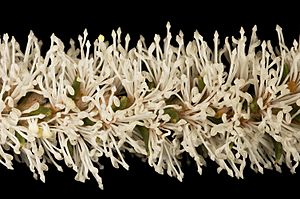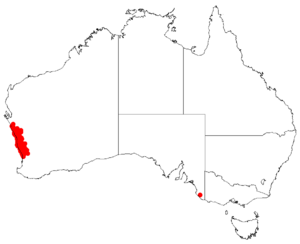Ribbed hakea facts for kids
Quick facts for kids Ribbed hakea |
|
|---|---|
 |
|
| Hakea costata | |
| Scientific classification | |
| Genus: |
Hakea
|
| Species: |
costata
|
 |
|
| Occurrence data from AVH | |
The Ribbed Hakea (scientific name: Hakea costata) is a cool shrub that grows in Western Australia. It's part of a plant family called Proteaceae. This small plant has many stems and shows off beautiful pink or white flowers that look like brushes. These flowers are full of sweet nectar and bloom from July to October.
Contents
What Does Ribbed Hakea Look Like?
The Ribbed Hakea is an upright shrub that can grow from about 0.3 to 2 meters (1 to 6.5 feet) tall. It doesn't have a special woody base that regrows after fire, which is called a lignotuber.
Branches and Leaves
When the plant is flowering, its smaller branches are covered with soft, straight hairs. The leaves look different depending on where they are on the shrub.
- Leaves near the flowers are usually thin and stiff. They are shaped like a triangle if you cut them across. These leaves are about 8 to 16 millimeters (0.3 to 0.6 inches) long and 1 to 2.5 millimeters (0.04 to 0.1 inches) wide.
- Leaves below the flowers are flat and shaped like a narrow egg or oval. They are about 2 to 5 millimeters (0.08 to 0.2 inches) wide.
The top side of the leaves looks smooth with no clear veins. But if you look underneath, you can see a strong middle vein.
Flowers and Fruit
The Ribbed Hakea has 8 to 12 strongly scented flowers that are white or pink. They grow in clusters called racemes (which means they grow along a stem) that are about 8 to 16 centimeters (3 to 6 inches) long. These flower clusters appear where the leaves meet the stem, from July to October.
The flower parts that surround the reproductive organs (called the perianth) are creamy white. The female part of the flower, called the pistil, is about 6 to 9 millimeters (0.2 to 0.35 inches) long.
After the flowers, small fruits grow directly on the stem without a stalk. They are somewhat egg-shaped, about 0.9 to 1 centimeter (0.35 to 0.4 inches) long and 0.6 to 0.8 millimeters (0.02 to 0.03 inches) wide. They are slightly curved and have a short beak-like tip. The surface of the fruit can be smooth or a little bumpy. Inside, the seeds are dark brown and shaped like an oval. They have a wide wing on one side and a narrower wing on the other, which helps them fly in the wind.
How Ribbed Hakea Got Its Name
The Ribbed Hakea was first officially described by a botanist named Carl Meissner in 1845. He wrote about it in a book called Plantae Preissianae.
The second part of its scientific name, costata, comes from the Latin word costatus. This word means "ribbed," and it refers to the long ridges or "ribs" you can see on the leaves of this plant.
Where Does Ribbed Hakea Grow?
The Ribbed Hakea is a special plant because it is endemic to a specific area. This means it only grows naturally in one place in the world! For the Ribbed Hakea, that place is along the west coast of Western Australia.
You can find it in the Wheatbelt and Mid West regions. Its range stretches from a town called Kalbarri in the north down to Yanchep in the south. It likes to grow in sandy soils that are found over limestone or laterite rock.

